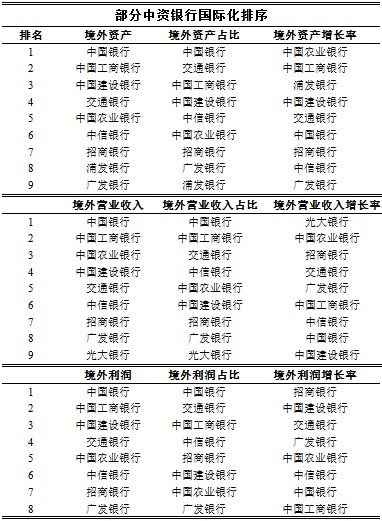《中資銀行國際化報告2015》發布稿
鉅亨網新聞中心
改革開放至今已近40年,中國金融市場在引進大量外資的同時,也在積極融入國際市場,各類中資金融機構,尤其是中資銀行都在為拓展海外市場而努力且初具規模。一方面,中資銀行的國際化發展是中國金融市場對外開放的重要體現,其本身的規模、區位選擇和模式探索都具有較大的研究價值;另一方面,銀行是金融服務的重要供給者,為現代企業的發展提供了必不可少的金融支援,中資銀行的海外發展現狀既可反映中資企業的海外發展情況,也會對往后的中資企業國際化拓展產生重要影響。
中資銀行國際化指數編制
在國際經濟呈現分化新格局、國內經濟步入運行新常態的背景下,在人民幣跨境使用規模范圍齊升、國內資本市場逐步開放的趨勢下,在走出去戰略、一帶一路戰略積極推行的歷史契機下,本報告著眼於直觀且深入地分析中資銀行的國際化現狀,通過層次分析法(Analytic Hierarchy Process,簡稱AHP),選取三類指標從境外資產積累、營業情況、分支機構以及海外並購等多方面建立中資銀行國際化指數(Chinese Banks Internationalization Index ,簡稱CBII),並分別對國際化實踐較為豐富的大型商業銀行和股份制銀行進行指標評估與排序,兩個指數體系主要區別存在於具體指標參數的選擇和權重的設定。本報告希望通過CBII的編制,綜合反映我國銀行業的國際化程度,使各中資銀行正確認識自己目前的發展水平及市場地位;並通過數據的實時更新反映其動態進程,分析中資銀行在國際化進程中出現的新挑戰和機遇,有利於中資銀行更好地制定下一步的國際化發展戰略。同時,CBII也為評估其他金融機構的境外發展水平提供了可借鑒的方法與思路。
中資銀行國際化排名
根據上述CBII編制方法,本報告計算出了5家大型商業銀行和部分股份制銀行的CBII數值,並對其進行了排名,具體如下:

注:本表中顯示的CBII排名采用的是“模擬體系”的排名結果。因5家大型商業銀行與股份制銀行有較大區別,因此在設計CBII指標時分別針對大型商業銀行和股份制銀行建立了兩套體系,其中指標具體參數和權重的設定都不同,其指數結果不可直接比對。為解決此問題,本報告將大型商業銀行的數據代入到股份制銀行的模型中,得出本表指數作為排名的一種參考。

基於中資銀行國際化指數結果以及相關發展現狀數據,本報告得出中資銀行國際化發展的五個核心結論:
五大行國際化中國銀行遙遙領先。從指數來看,中國銀行連續8年國際化指數為五大行平均水平的5倍以上,最大時為3.5倍;工商銀行與交通銀行近8年基本位於五大行平均水平線上;建設銀行和農業銀行國際化稍顯滯后;從增速來看,農業銀行年均增速最大,隨后依次為工行、建行和交行,中行略有負增長(可能由於邊際增速遞減而引起)。五大行的2014年國際化水平由高至低依次為:中國銀行(20.99)、中國工商銀行(8.17)、交通銀行(7.12)、中國建設銀行(4.08)、中國農業銀行(2.72)。 股份制銀行國際化中信銀行占得先機。從指數來看,中信銀行國際化水平大幅領先,約為三家銀行綜合平均水平的5倍,招商銀行和廣發銀行則在平均水平線下方;從增速來看,廣發銀行增長最快,其次為招商銀行,中信銀行的國際化進程則近5年陷入停滯。部分股份制銀行的2014年國際化水平由高至低依次為:中信銀行(4.38)、招商銀行(2.29)、廣發銀行(1.22)。 中資銀行境外資產、營收和利潤占比遠低於國際大型銀行。近8年五大行平均境外資產、營收和利潤占比分別為09%、6.12%和6.30%,而相應的花旗銀行數值為60.29%、50.59%、50.32%,匯豐銀行為48.36%、62.35%、69.05%,約為五大行平均值的8倍。由此可見中資銀行的國際化發展與國際先進水平差距甚遠。 中資銀行境外資產、營收和利潤增速持續高於國內經濟發展。除了受2008年次貸危機的影響以及國內四萬億投資的驅動外,2007年至2014年的8年間,中資銀行境外資產、業務發展在大多數年份保持了顯著高於境內業務、對外直接投資(ODI)、對外貿易以及我國GDP的增長,尤其是五大行的境外業務近幾年平均增速高達56%。而在五大行中,境外資產規模最小的農業銀行近些年境外業務增速最為突出,2014年達到了76.77%,是五大行平均增長率的2.6倍。 五大行海外機構近一半在亞洲,分布集中。從總量上來看,中國銀行和中國工商銀行境外機構遠多於其他三家銀行,幾乎占到了四分之三。從地區分布上來看,五大行海外機構約一半集中在亞洲地區,說明國內銀行對外擴張時多以周邊地區作為首發地點,同時,近些年亞太地區新興國家發展迅速,對金融服務的需求大幅增長,促使了中資銀行在亞太地區的業務拓展。另外,歐洲和美洲等發達地區的分支機構數量顯著高於非洲地區,這表明除了擁有地緣優勢的周邊國家和地區之外,中資銀行資本會優先向資本充裕的發達國家流動。
中資銀行海外發展戰略建議
在充分了解目前中資銀行的國際化發展階段和現狀的基礎上,本報告總結了國內外金融機構的海外發展經驗,提出下列戰略建議。首先,各銀行應立足自身實際,審慎制定國際化規劃,結合自身實際進行海外擴張,切勿跟風;其次,在“走出去”的區位選擇上,應牢牢抓住國家政策的機遇,加強與“一帶一路”沿線國家的金融合作,同時向新加坡、香港等發達金融市場國家拓展,並向努力填補歐洲空白,加強在非洲、拉丁美洲等國家的版面。再者,在“走出去”的模式選擇上,對於剛走上國際化道路的商業銀行來說,若東道國監管限制較低,先采用新設境外機構的方式或許相對穩妥一些,待熟悉環境,找到合適的收購對象之后,再通過並購重組、機構整合的方式實現現有機構的有效擴張。最後,在有著積極預期的海外發展前景下,中資金融機構應堅持“走出去”的發展目標,拓寬境外發展區位選擇,正確選擇海外發展模式,並積極抓住國家政策機遇,實現穩健而快速的海外發展。在“走出去”的機構形式選擇上,初期可設立代表處,之后可考慮通過分行發揮集團優勢,通過子行設立防火墻。
最後,本報告的指標體系是開放且保持動態調整的。隨著中資銀行“走出去”的步伐不斷加快、“走出去”的方式逐漸多樣,中資銀行的國際化統計指標一定會更加完善。
Press Release?Report on The Internationalization of Chinese Banks?2015
Center for Internet & Financial Innovation (CIFI), Zhejiang University,
in partnership with?International Monetary Institute (IMI), Renmin University of China &?International Finance Institute, Bank of China?are pleased to release the progress report of a research project on Chinese banks’ global expansion with the key findings and recommendations summarized below.
After nearly 40 years’ development since China’s Reform and Opening Up, the financial markets in China have gradually integrated into the global markets. Particularly for Chinese local financial institutions, their attempts to explore oversea markets and to expand their business abroad have achieved many remarkable successes, but clearly there is still a long way to go. In this report, we try to analyze Chinese banks’ level of internationalization by introducing the Chinese Banks Internationalization Index (CBII). This index is designed to dynamically capture the internationalization process of different Chinese banks over time, and the analytical results provide some insightful implications for both regulatory agencies and financial institutions.
The Chinese Banks Internationalization Index (CBII)
The CBII is constructed based on a multiple set of criteria: (1) the oversea assets accumulation, (2) the operation of oversea business, (3) the number of overseas branches, (4) the number of cross-border M&A, etc. We also differentiate the Big 5 large commercial banks, which have gained more experiences in the process of internationalization, and the shareholding commercial banks when selecting the key driving factors and their corresponding weights. The Analytic Hierarchy Process (AHP) method is then applied to find out the optimal weights for each factor.
Rankings & Major Findings
- Bank of China is most internationalized among the “Big 5” state-owned banks. The CBII indicates that Bank of China has the highest level of internationalization with its index value 2.5 times (3.5 times highest) above all five banks’ average from year 2007 to 2014. And Agricultural Bank of China is accelerating its pace of internationalization, although in general is still largely falling behind. As of 2014, the CBII value for BOC, ICBC, Bank of Communication, CCB and ABC were 20.99, 8.17, 7.12, 4.08 and 2.72 respectively.
- CITIC Bank is in the lead among shareholding commercial banks. In contrast with China Merchants Bank and Guangdong Development Bank, CITIC Bank is overall more internationalized, but on the other hand, its growth rate has slowed down largely over the past 5 years, while Guangdong Development Bank is quickly catching up. At the end of 2014, the CBII for CITIC Bank, CMB and GDB stood at 4.38, 2.29 and 1.22.
- Chinese banks’ contributions from oversea business are still low. For the “Big 5” state-owned banks, from 2007 to 2014 the percentages of assets, revenue and net profits generated outside of China are only 8.09%, 6.12% and 6.30% respectively, which are significantly behind global banks like like CITI Bank (60.29%, 50.59%, 50.32%) and HSBC (48.36%, 62.35%, 69.05%).
- But Chinese banks’ oversea business is growing fast. Excluding the influences from 2008 global financial crisis and Chinese government’s four trillion yuan ($586 billion) stimulus investments, Chinese banks’ oversea business have expanded at a much higher speed over the past 8 years, compared favorably with China’s ODI and GDP growth rates during the same period. Particularly for the “Big 5” state-owned banks, the growth rate has reached 28.56% on average in recent years, with Agricultural Bank of China growing at a stunning 76.77% in 2014, albeit from a much modest base.
- Almost half of the oversea branches of “Big 5” banks are located in Asia. Geographically, nearly half of “Big 5” state-owned banks’ oversea branches are located in Asia. Besides, there are clearly more branches in more developed regions like Europe and North America than in less developed regions like Africa, implying that developed markets are still the major targets for Chinese banks’ capital outflows. Among the Big 5, Bank of China and ICBC have the widest oversea branch network, taking up almost 3/4 of the total number.
Strategic Advice for Overseas Expansion
- Banks should be more prudent, when developing their internationalization strategies. The strategies should reflect banks’ own capabilities and business priorities. Simply copying others is fraught.
- Banks should follow the trend of (Chinese) government policies and priorities more closely. In this connection banks should consider expanding their businesses and network along the “One Belt and One Road” countries and markets, while continuing making strategic deployments in developed markets.
- Banks should pay more attention to the financial regulations in different countries. For countries with lower regulatory barriers, banks could consider entering the market by establishing local branches, and further expanding the business by acquiring other local banks.
- Different forms of foreign branches should be considered at different development stages. At the early stage with a lot more “uncertainties” and “unknowns”, a representative office is a quick way to establish some presence, while at more mature stages and with more global operating experiences, branch office or bank subsidiary should be considered.
The research has been conducted, over a period of 9 months by a team comprising of faculty and research assistants in Zhejiang University and is headed by Prof Ben Shenglin, Executive Director of IMI and Director of CIFI.
Beijing? Sept 20, 2015
文章標籤
- 講座
- 公告
上一篇
下一篇